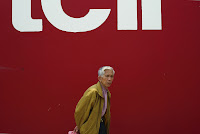.jpg)
Anne Hathaway, San Francisco, November 2007.


I have a secret fantasy: I’m a Magnum correspondent. I'm not in front of the Gap, I'm in the trenches of Cordoba in '36, buried in mud, dodging enemy fire with Capa. I'm not shooting a flower stand on a windy spring day, I'm with Koudelka covering the Spring Invasion of Prague. This thing before me is not just a boring red wall, it's the barbed Wall of Berlin, and when it comes crashing down I will beat Nachtwey to the punch.
Then something happens: a man walks by with a Pixy Stix in his mouth. Suddenly I'm back in front of the Gap, poised to catch the exact moment the Pixy Stix points to the air, and I nail the shot with dogged determination like it was the Falling Soldier himself. It has been a good day for waiting.
The French photographer Robert Doisneau knows a thing or two about waiting and the theatricality of everyday life. In his book, Paris, he said:
Seeing sometimes means constructing a little theater with the materials at hand, and then awaiting the arrival of the actors.Even in the lowly theater of the Gap or a flower stand, actors could show up and something could happen. A man could enter with a Pixy Stix in his mouth. A sudden gush of wind could create a little human crisis. An old Chinese man with hands on his back could enliven a boring red wall.
Which actors?
I don't know, but I wait.
I just keep hoping and believing real hard – and damned if they don't finish by showing up.
Not exactly Capa, but human moments just the same. And they will do very nicely until the first war assignment comes along.
VIDEO: Robert Capa, Photographs of the Spanish Civil War




Robert Capa, Falling Soldier, Cerro Muriano (Cordoba Front), 1936.
James Nachtwey, Berlin Wall Comes Down, 1989.
Josef Koudelka, From Invasion, Prague, 1968.
Robert Doisneau, Diagonal Steps, Paris, 1953.
No comments:
Post a Comment